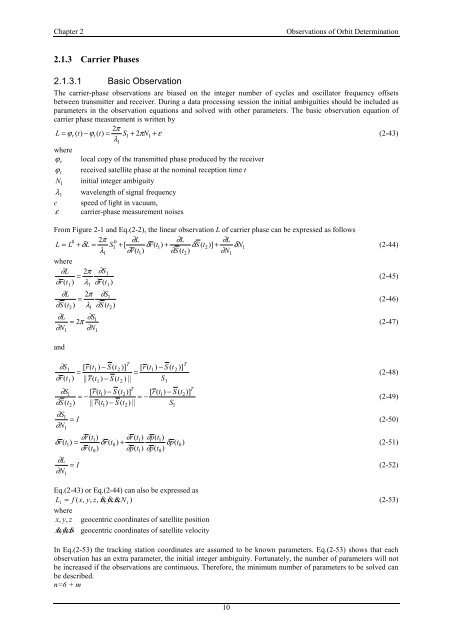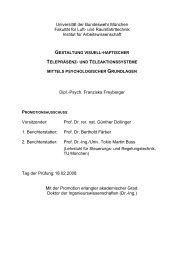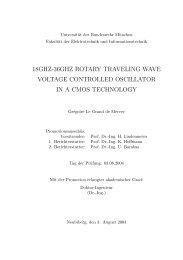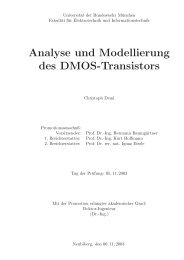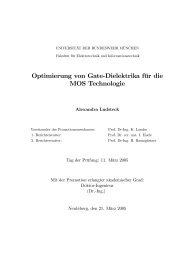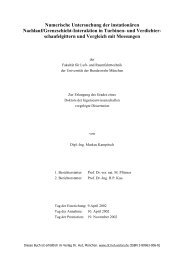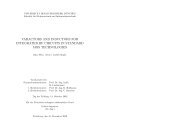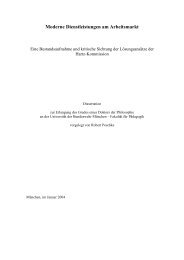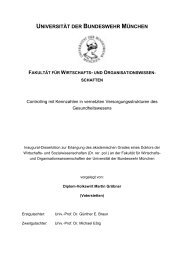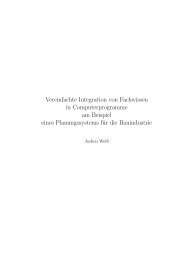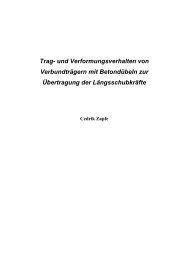Precise Orbit Determination of Global Navigation Satellite System of ...
Precise Orbit Determination of Global Navigation Satellite System of ...
Precise Orbit Determination of Global Navigation Satellite System of ...
Create successful ePaper yourself
Turn your PDF publications into a flip-book with our unique Google optimized e-Paper software.
Chapter 2 Observations <strong>of</strong> <strong>Orbit</strong> <strong>Determination</strong><br />
2.1.3 Carrier Phases<br />
2.1.3.1 Basic Observation<br />
The carrier-phase observations are biased on the integer number <strong>of</strong> cycles and oscillator frequency <strong>of</strong>fsets<br />
between transmitter and receiver. During a data processing session the initial ambiguities should be included as<br />
parameters in the observation equations and solved with other parameters. The basic observation equation <strong>of</strong><br />
carrier phase measurement is written by<br />
2π<br />
L = ϕ r ( t)<br />
−ϕt<br />
( t)<br />
= S1<br />
+ 2πN1<br />
+ ε<br />
λ1<br />
where<br />
ϕ r local copy <strong>of</strong> the transmitted phase produced by the receiver<br />
ϕ t received satellite phase at the nominal reception time t<br />
initial integer ambiguity<br />
N 1<br />
λ 1<br />
wavelength <strong>of</strong> signal frequency<br />
c speed <strong>of</strong> light in vacuum,<br />
ε carrier-phase measurement noises<br />
1<br />
1<br />
10<br />
(2-43)<br />
From Figure 2-1 and Eq.(2-2), the linear observation L <strong>of</strong> carrier phase can be expressed as follows<br />
0 2π<br />
0 ∂L<br />
∂L<br />
∂L<br />
L = L + δ L = S1<br />
+ [ δr<br />
( t1)<br />
+ δS<br />
( t2)]<br />
+ δN1<br />
λ1<br />
∂r(<br />
t1)<br />
∂S<br />
( t2)<br />
∂N1<br />
where<br />
(2-44)<br />
∂L<br />
2π<br />
∂S1<br />
=<br />
∂r<br />
( t1)<br />
λ1<br />
∂r<br />
( t1)<br />
(2-45)<br />
∂L<br />
2π<br />
∂S1<br />
=<br />
∂S<br />
( t2)<br />
λ1<br />
∂S<br />
( t2)<br />
(2-46)<br />
∂L<br />
∂N<br />
∂S1<br />
= 2π<br />
∂N<br />
(2-47)<br />
and<br />
∂S1<br />
[ r(<br />
t1)<br />
− S ( t2<br />
)] [ r ( t1)<br />
− S ( t 2 )]<br />
=<br />
=<br />
∂r<br />
( t ) || r(<br />
t ) − S ( t ) || S<br />
1<br />
1<br />
t2<br />
1<br />
1<br />
T<br />
2<br />
T<br />
t2)]<br />
( t2)<br />
∂S<br />
[ r ( t1)<br />
− S ( [ r ( t1)<br />
− S ( t<br />
= −<br />
= −<br />
∂S<br />
( ) || r ( t ) − S || S<br />
∂S<br />
1 = I<br />
∂N<br />
1<br />
1<br />
1<br />
T<br />
2<br />
)]<br />
T<br />
(2-48)<br />
(2-49)<br />
(2-50)<br />
∂r(<br />
t1)<br />
∂r<br />
( t1)<br />
∂p(<br />
t1)<br />
δ r( t1)<br />
= δr(<br />
t0)<br />
+<br />
δp(<br />
t0)<br />
(2-51)<br />
∂r(<br />
t ) ∂p(<br />
t ) ∂p(<br />
t )<br />
∂L<br />
= I<br />
∂N<br />
1<br />
0<br />
1<br />
0<br />
(2-52)<br />
Eq.(2-43) or Eq.(2-44) can also be expressed as<br />
Li = f ( x,<br />
y,<br />
z,<br />
x&<br />
, y&<br />
, z&<br />
, N i )<br />
(2-53)<br />
where<br />
x, yz , geocentric coordinates <strong>of</strong> satellite position<br />
xyz &, &, & geocentric coordinates <strong>of</strong> satellite velocity<br />
In Eq.(2-53) the tracking station coordinates are assumed to be known parameters. Eq.(2-53) shows that each<br />
observation has an extra parameter, the initial integer ambiguity. Fortunately, the number <strong>of</strong> parameters will not<br />
be increased if the observations are continuous. Therefore, the minimum number <strong>of</strong> parameters to be solved can<br />
be described.<br />
n=6 + m


